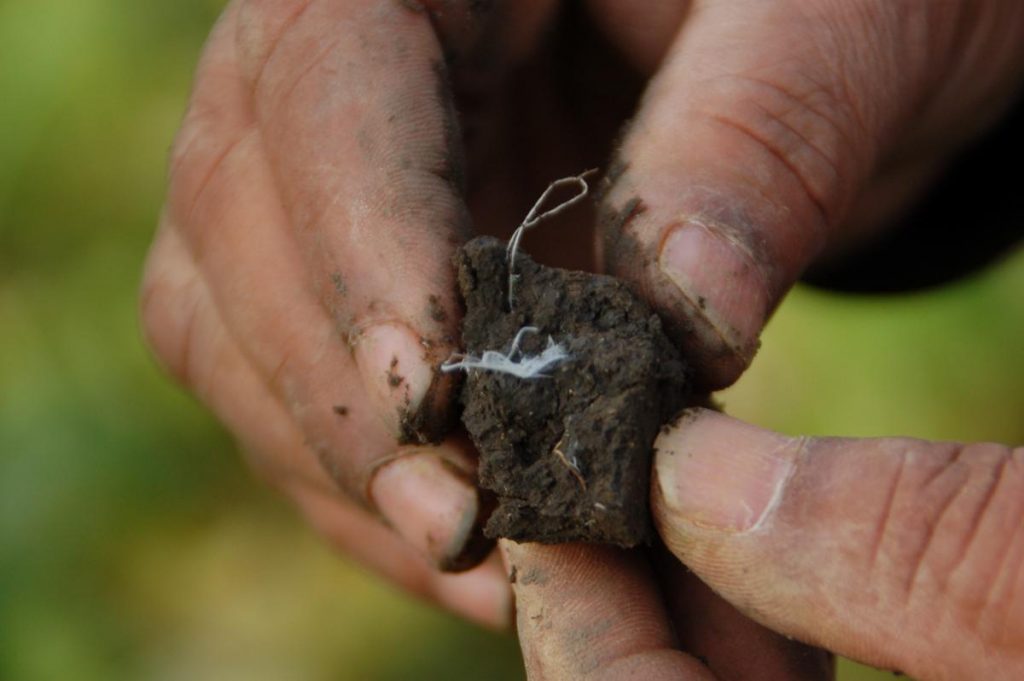What are Fungi and Bacteria?
Fungi are microscopic plant-like cells which grow as long strands called hyphae, which in turn create masses known as mycelium. These soil microorganisms perform functions such as nutrient cycling, compound transformation, disease suppression, water fluctuations, and ecosystem regulators. Bacteria are microscopic one-celled organisms which primarily serve as decomposers, but can also function in the soil as partners with plants, as nitrogen-fixers, as pathogens, or as lithotrophs.
Do you have an excellent resource that isn’t listed here? Submit it for consideration.
| Title | Source | Resource type and Date | Short Summary / Preview |
|---|---|---|---|
| Purdue Soil Health Education website | Purdue Soil Health Education website | Video
Sep 2017 |
Dr. John Graveel, Purdue Agronomy Department discusses microbiology activity within soils. |
| The Living Soil: Fungi | USDA | NRCS Webpage
Not Dated |
Fungi are microscopic cells that usually grow as long threads or strands called hyphae, which push their way between soil particles, roots, and rocks. |
| The Living Soil: Bacteria | USDA | NRCS Webpage
Not Dated |
Bacteria are tiny, one-celled organisms – generally 4/100,000 of an inch wide (1 µm) and somewhat longer in length. What bacteria lack in size, they make up in numbers. A teaspoon of productive soil generally contains between 100 million and 1 billion bacteria. That is as much mass as two cows per acre. |
| Role of Soil Fungus | The Ohio State University | Extension Webpage
Jun 2016 |
Fungi are an important part of the microbial ecology. |
| Role of Soil Bacteria | The Ohio State University | Extension Webpage
Jun 2016 |
Microbes in the soil are directly tied to nutrient recycling especially carbon, nitrogen, phosphorus and sulfur. Bacteria are a major class of microorganisms that keep soils healthy and productive. |
| PLFA video protocol | JoVE from University of Wisconsin-Madison reseachers | Video
2017 |
This video protocol explains how phospholipid fatty acid analysis is done and how to interpret the data. |
| Title | Source | Resource type and date | Short Summary |
|---|---|---|---|
| Fungi vs. bacteria | The University of Western Australia | University Webpage
Not Dated |
Discussion of the different roles of fungi and bacteria as well as ratios. |
| Title | Source | Resource type and Date | Short Summary |
|---|---|---|---|
| Microbial Biomass C, N | Michigan State University, LTER | Extension / Research Protocol
Not Dated |
Protocol to measure microbial biomass in the soil. |
| Using a soil bacterial species balance index to estimate potato crop productivity | PLOS ONE | Peer-Reviewed Publication
Mar 2019 |
Assessed the bacterial diversity of soils in 51 potato production plots. Observed a significant impact of soil texture balances on potato yields. Soil biodiversity did impact potato yields. |
| Equations for Soil Microbial Biovolume and Carbon Calculation | Michigan State University, LTER | Extension / Research Protocol
Not Dated |
The equations for calculation of soil microbial biovolume and carbon are specified. |
| Fungal Biodiversity and Their Role in Soil Health | Frontiers in Microbiology | Peer-Reviewed Publication
Apr 2018 |
This mini review focuses on fungal biodiversity and its role in the health of managed soils as well as on the current methods used in soil mycobiome identification and utilization next generation sequencing (NGS) approaches |
Last reviewed 10/24/19
